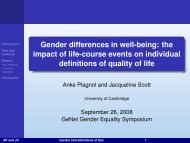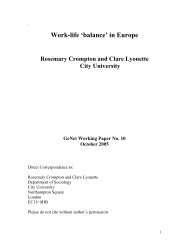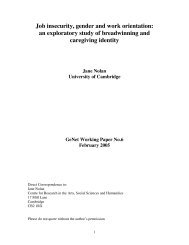Guidelines for Gender Equality Programmes in Science - GeNet
Guidelines for Gender Equality Programmes in Science - GeNet
Guidelines for Gender Equality Programmes in Science - GeNet
Create successful ePaper yourself
Turn your PDF publications into a flip-book with our unique Google optimized e-Paper software.
The second strategy aims to <strong>in</strong>clude the gender dimension <strong>in</strong> the very process of research<br />
and <strong>in</strong>novation design<strong>in</strong>g. Two ma<strong>in</strong> objectives were identified <strong>in</strong> this regard:<br />
– overcom<strong>in</strong>g stereotypes of women and science;<br />
– <strong>in</strong>fluenc<strong>in</strong>g scientific contents and methods.<br />
The third strategy consists of promot<strong>in</strong>g women <strong>in</strong> scientific leadership positions. In this case,<br />
four objectives emerged from the analysis of the programmes:<br />
– support<strong>in</strong>g women’s leadership <strong>in</strong> research practice;<br />
– support<strong>in</strong>g women’s leadership <strong>in</strong> research management;<br />
– support<strong>in</strong>g women’s role <strong>in</strong> science communication;<br />
– <strong>in</strong>creas<strong>in</strong>g women’s presence and weight <strong>in</strong> manag<strong>in</strong>g <strong>in</strong>novation processes and <strong>in</strong> the<br />
related science-society relationships.<br />
On the whole, the <strong>Guidel<strong>in</strong>es</strong> conta<strong>in</strong> 31 recommendations <strong>for</strong> implement<strong>in</strong>g the three strategies,<br />
along with 61 l<strong>in</strong>es of action. In turn, the l<strong>in</strong>es of action are accompanied by 219 examples<br />
drawn from the experience of gender equality programmes. For each example, at least<br />
one web address is provided <strong>in</strong> order to allow direct access to relevant <strong>in</strong><strong>for</strong>mation sources.<br />
The structure briefly described above is summarised <strong>in</strong> the summary charts 1-3 attached to<br />
this Executive Summary.<br />
A cross-cutt<strong>in</strong>g look at equality programmes <strong>in</strong> S&T<br />
In addition to this substantive view, the <strong>Guidel<strong>in</strong>es</strong> also attempt to provide a cross-cutt<strong>in</strong>g<br />
analysis of the programmes <strong>in</strong> order to identify the practical solutions and orientations they<br />
developed, regardless of the strategies adopted and the objectives pursued.<br />
Three doma<strong>in</strong>s are considered.<br />
The first <strong>in</strong>cludes the tools used by the programmes to achieve their objectives. Needless to<br />
say, a tool can be applied to achieve different objectives and to implement different strategies,<br />
and even several strategies at the same time. A total of 31 tools have been s<strong>in</strong>gled out and<br />
are accompanied by 138 examples, each with a relevant web address.<br />
The second doma<strong>in</strong> concerns the action patterns, that is, the recurrent schemes of action<br />
which programme promoters use to assure acceptable quality levels to their programmes. A<br />
total of 30 action patterns have been identified and grouped <strong>in</strong>to four ma<strong>in</strong> quality dimensions:<br />
relevance, effectiveness, efficiency and susta<strong>in</strong>ability.<br />
The third doma<strong>in</strong> concerns some conclusions emerg<strong>in</strong>g from the entire analysis. These are<br />
presented <strong>in</strong> the <strong>for</strong>m of 7 overall methodological suggestions.<br />
The structure and contents of these three doma<strong>in</strong>s are summarised <strong>in</strong> the summary charts 4-<br />
6, attached to this Executive Summary.<br />
5






